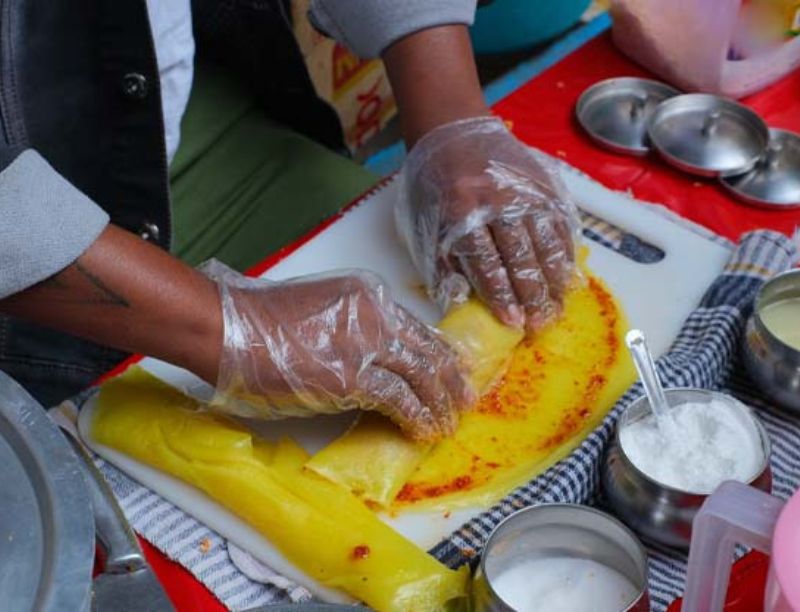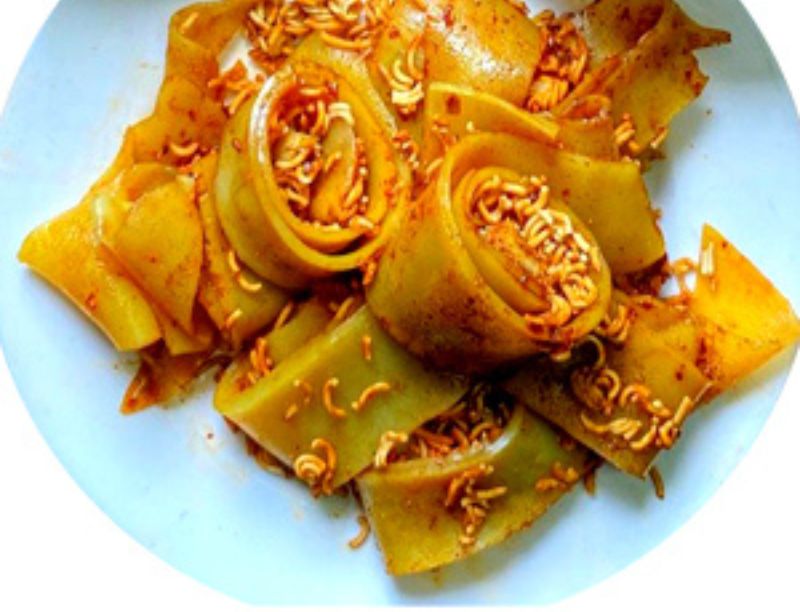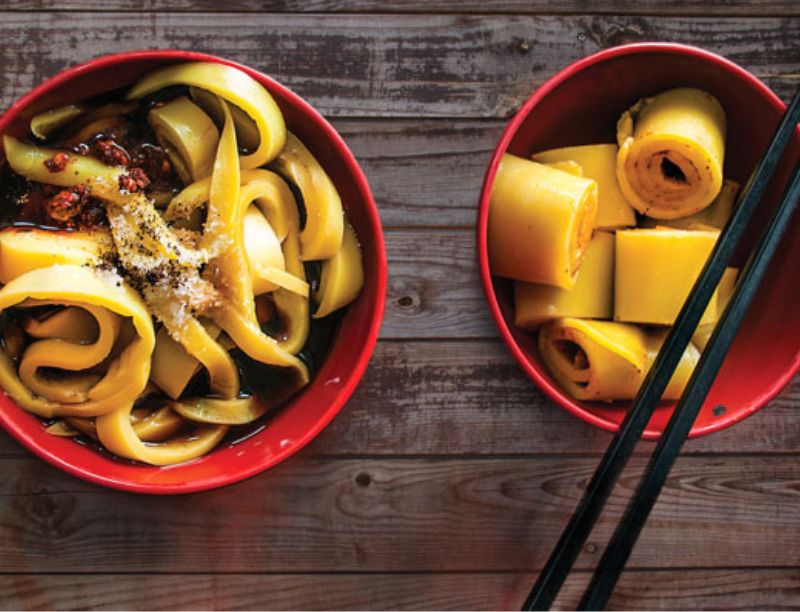Introduction
Laphing is a Tibetan street food that has taken the world by storm, especially in Nepal, India, and beyond. Known for its cold, spicy, and slippery texture, this noodle dish is an explosion of flavors and textures. The dish is trendy during the hot summer, providing a refreshing contrast to the heat. The following is a traditional Laphing recipe that can be easily prepared at home.
Laphing has its roots in the Tibetan community and is believed to have originated in Tibet’s cold, mountainous regions. The dish was initially consumed to beat the summer heat, with its cooling properties and light texture. Over time, Laphing became a staple food in the Tibetan diaspora, especially in Nepal and India.
Laphing has also been influenced by neighboring cuisines, mainly Chinese and Nepalese. In Nepal, the dish has evolved to include variations such as yellow laphing, which is made using turmeric or yellow food coloring. Despite these regional variations, the essence of Laphing remains the same—a refreshing, spicy, and slippery noodle dish perfect for hot weather.
Laphing Recipe Ingredients
The ingredients used in making Laphing are simple and easily accessible. Here’s a breakdown of the essential components:
- Mung Bean Flour (or Chickpea Flour): The main ingredient for the jelly base is mung bean flour, which gives Laphing its unique texture. Chickpea flour can also be used as an alternative.
- Water: Used to create the batter and cook the flour into a jelly-like consistency.
- Soy Sauce: Adds a salty, umami flavor to the dish.
- Vinegar: Provides acidity and a slight tanginess, balancing the dish’s flavors.
- Chili Oil: Chili oil is the spice element in Laphing, and it is a must-have for those who enjoy a bit of heat.
- Minced Garlic: Adds a pungent, aromatic element to the dish.
- Sesame oil: Adds a deep, nutty taste to the food.
- Salt: Enhances the overall taste of the Laphing.
- Fresh Cilantro: Used as a garnish, cilantro adds freshness and color to the dish.
These components come together to make a dish that is simple yet complex in flavor, making Laphing a beloved street food in many parts of the world.
Also Read: Chatpate Recipe: A Tangy Delight
Instructions:
- Prepare the Laphing Base: Mix the mung bean flour with water in a large bowl to create a smooth batter. Let it sit for a few hours to allow the flour to settle at the bottom.
- Cook the Batter: Pour the settled batter into a nonstick skillet over medium heat. Stir continuously to prevent lumps. Once it thickens and becomes translucent, remove from heat and pour into a tray to cool and set.
- Slice and Serve: Once the mixture has cooled and set into a jelly-like consistency, slice it into thin, long pieces.
- To Prepare the Sauce: Combine the soy sauce, vinegar, sesame oil, chili oil, and minced garlic in a small bowl. Adjust the amount of spice to suit your taste.
- Serve: Pour the sauce over the sliced Laphing. Garnish with fresh cilantro. Serve cold.
Tibetan Laphing Recipe
The traditional Tibetan Laphing recipe has remained essentially unchanged over the centuries. Here’s how you can make authentic Tibetan Laphing at home.

Ingredients:
- 1 cup of mung bean starch
- 4 cups of water
- 2 tablespoons of Tibetan chili paste (optional)
- 2 tablespoons of soy sauce
- 1 tablespoon of vinegar
- 1 teaspoon of minced garlic
- 1 teaspoon of sesame oil
- Salt to taste
Instructions:
- Prepare the Batter: Mix the mung bean starch with water until smooth. Let it sit for a few hours until the starch settles at the bottom.
- Cook the Batter: Pour the settled starch into a pot and stir-fry it over medium heat continuously. The mixture will thicken and turn translucent.
- Set the Laphing: Once thickened, pour the mixture into a tray to cool and set. Once set, it will have a jelly-like texture.
- Prepare the Sauce: In a bowl, mix Tibetan chili paste (if using), soy sauce, vinegar, minced garlic, and sesame oil.
- Serve: Slice the set Laphing into strips and pour the sauce over it. Serve cold, garnished with fresh cilantro.
This recipe is a classic representation of Tibetan cuisine, where simplicity and bold flavors combine to create a memorable dish.
Yellow Laphing Recipe
Yellow Laphing is a popular variation of the traditional dish, known for its bright color and slightly different flavor profile. The yellow hue is usually achieved by adding turmeric or yellow food coloring to the batter.
Ingredients:
- 1 cup of mung bean flour
- 4 cups of water
- 1 teaspoon of turmeric powder (or yellow food coloring)
- 2 tablespoons of soy sauce
- 1 tablespoon of vinegar
- 1 tablespoon of chili oil
- 1 teaspoon of minced garlic
- 1 teaspoon of sesame oil
- Salt to taste
- Fresh cilantro for garnish
Instructions:
- Prepare the Batter: Mix the mung bean flour with water and turmeric powder (or yellow food coloring) until smooth. Let it sit for a few hours until the starch settles at the bottom.
- Cook the Batter: Pour the settled mixture into a pot and cook, stirring, over medium heat continuously until it thickens and turns translucent with a yellow tint.
- Set the Laphing: Pour the mixture into a tray to cool and set.
- Prepare the sauce: Combine vinegar, chili oil, minced garlic, and sesame oil in a bowl.
- Serve: Slice the yellow Laphing into strips and pour the sauce over it. Garnish with fresh cilantro and serve cold.
Yellow Laphing is particularly popular in Nepal and offers a visually appealing and flavorful twist on the traditional dish.
Is Laphing Healthy?
Laphing is a relatively healthy dish, especially considering its ingredients and preparation method. Here’s a breakdown of its nutritional benefits:

- Low in Calories: Laphing is made primarily from mung bean starch, which is low in calories. This makes it an excellent option for those eager to savor a substantial meal without eating too many calories.
- Rich in Protein: Mung bean flour is high in plant-based protein necessary for muscle repair and growth.
- Digestive Benefits: The dish is light and easy to digest, making it a perfect summer meal. Adding vinegar and garlic to the sauce can also aid digestion.
- Customizable Spice Level: The chili oil used in Laphing can be adjusted according to personal preference, allowing individuals to control the spice level and make it suitable for their taste.
- Vegan-Friendly: Laphing is typically vegan, as it contains no animal products. This makes it an excellent option for those following a plant-based diet.
However, like any dish, the healthiness of Laphing can depend on how it is prepared and consumed. For instance, excessive use of chili oil or soy sauce can increase the sodium and fat content of the dish. Therefore, it’s essential to enjoy Laphing in moderation, modifying the ingredients to suit your dietary requirements.
Conclusion
Laphing is a versatile and delicious dish with flavor and various health benefits. Whether trying it for the first time or looking to make it at home, Laphing will undoubtedly become one of your favorite dishes. Making Laphing at home is a rewarding experience that allows you to enjoy this beloved Tibetan dish in the comfort of your kitchen. Laphing will indeed become your household favorite. You can create an authentic and delicious dish by following this detailed recipe and using the right ingredients.
Read More: Kurmure: A Popular Crunchy Snack

